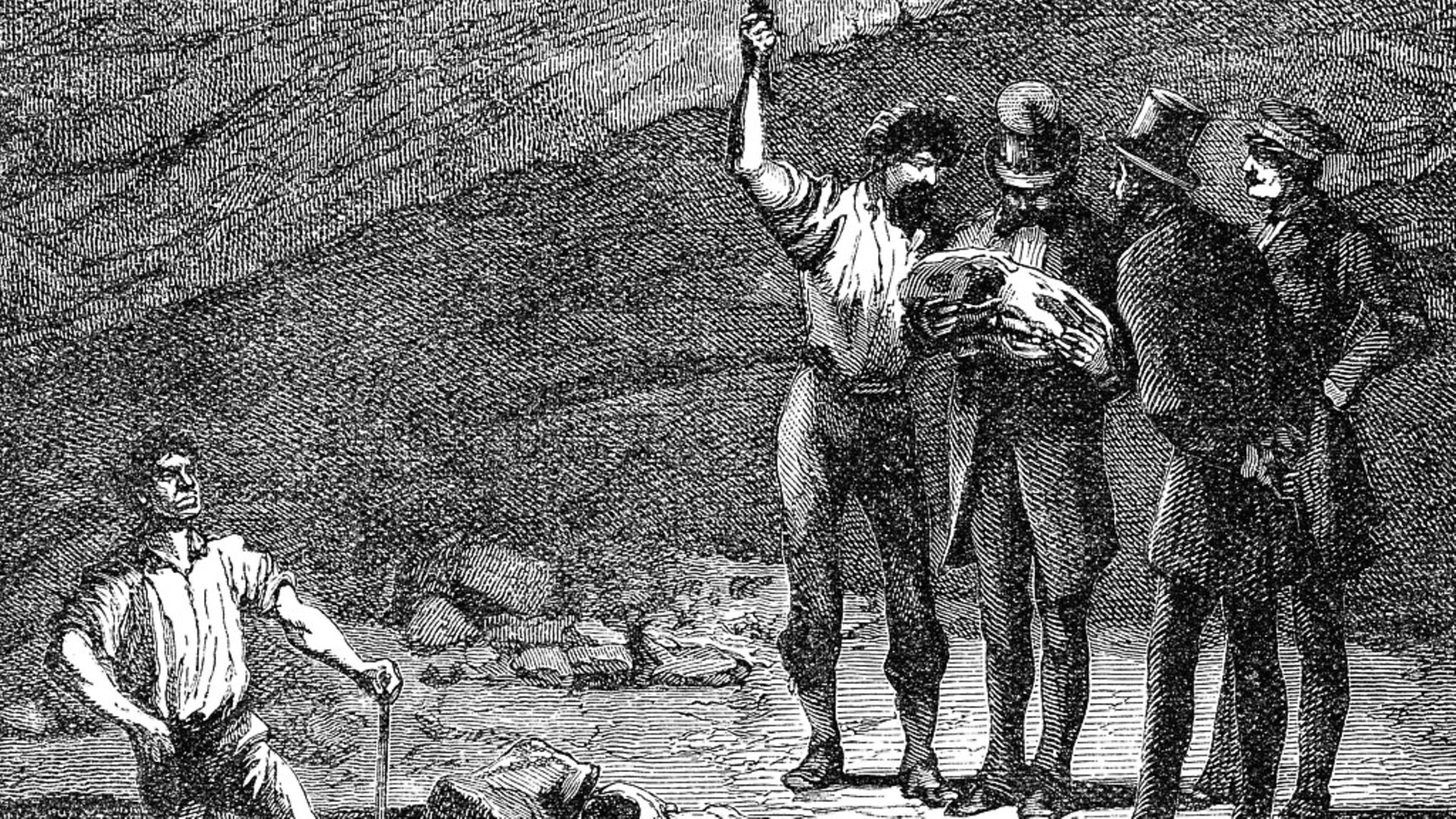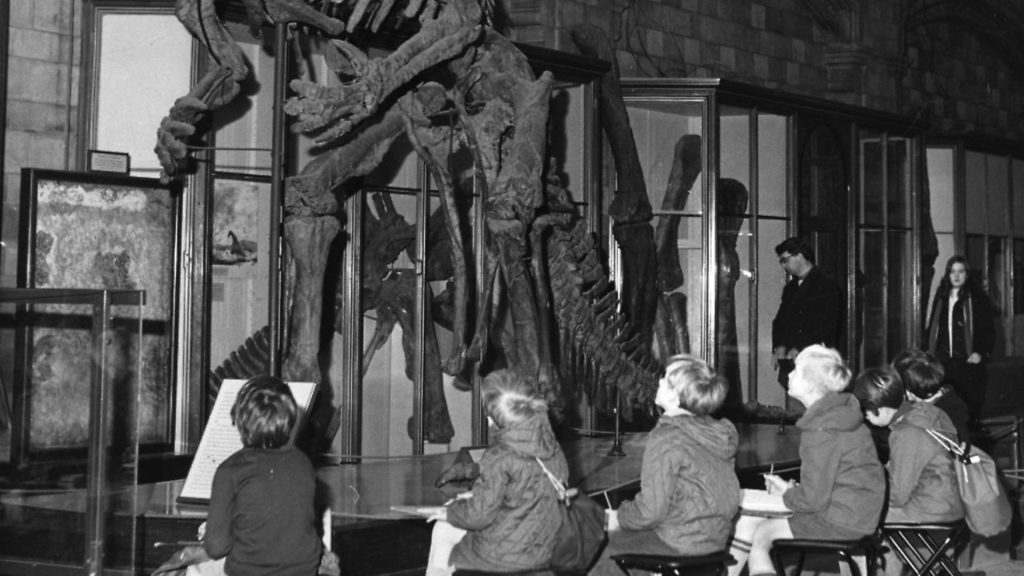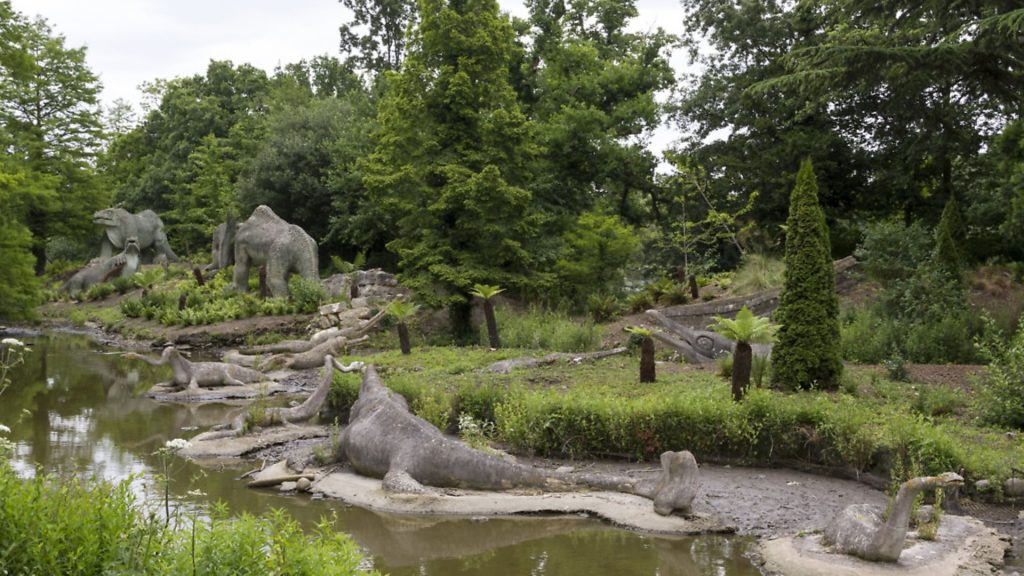
RICHARD LUCK looks back on a little-known chapter from history, when a chance discovery in a Belgian backwater produced one of science’s greatest ever finds.

‘I think I’ve struck gold!’ So bellowed miner Jules Creteur upon discovering something sparkling 322 metres below the surface on a Belgian coal field.
As is so often the case, what glisters was in fact iron pyrite, which looks pretty but is far from priceless. In this instance, the ‘fool’s gold’ formed part of a fossilised tree stump. Irritated, Creteur removed the ancient relic and resumed digging. Which is when he really struck gold.
What emerged from that mine in Bernissart, on the French border, close to the town of Mons, was among the most important discoveries of any age.
By the time the palaeontologists were done with the site, 30 near-complete dinosaur skeletons had been excavated. And what this epic find from 1878 revealed would hugely advance our understanding of the beasts that dominated this planet for 165 million years.

Long though they might have ruled the world, dinosaurs have only been known to science for two centuries. Before then, remains of ‘terrible lizards’ were written off as belonging to extinct races of dragons (especially true of China), giants (pretty much anyplace the Bible held sway) or animal species that had been wiped out by the Biblical flood (see giants).
Though the term dinosaur (Greek for ‘terrible lizard’) was coined by the biologist and palaeontologist Sir Richard Owen in 1842, the first remains were unearthed some 20 years earlier. It is these identifications – by Gideon Mantell and William Buckland – that the Royal Mint has this year chosen to celebrate with a trio of commemorative 50 pence pieces.
Of the three species depicted – Megalosaurus, Hylaosaurus and Iguandon – it’s the last of these that’s of particular interest. Translating as ‘Iguana tooth’, Iguanodon came to mankind’s attention when Mary Ann Mantell, Gideon’s wife, chanced upon some fossilised teeth while her husband, a Sussex GP, was visiting a patient near Lewes.
Recognising that the remains belonged to a long extinct creature, Gideon Mantell’s determination to correctly identify the teeth led to Iguanodon becoming the first celebrity of the dinosaur world.

Indeed, after further Iguanodon remains were unearthed near Maidstone, Kent, interest in dinosaurs swelled to such an extent that, when the Crystal Palace was relocated from Hyde Park to South London in the 1850s, the sculptor Benjamin Waterhouse Hawkins was commissioned to create 33 prehistoric animal statues to take up place in the parkland beneath the great glass structure.
Naturally, pride of place went to a pair of Iguanodons which Waterhouse Hawkins constructed under the watchful eye of Sir Richard Owen. Owen was convinced that the species of old resembled modern-day animals.
As such, ‘his’ Iguanodons looked rather like Haitian Rhinoceros Iguanas, complete with nose horns. Quite how wrong Sir Richard had got things only became apparent some 30 years later when a band of Belgian miners made the discovery of a lifetime.
Mention dinosaur discoveries and the Gobi Desert and the Montana Badlands are more likely to come to mind than the Low Countries. Yet it was in Bernissart, a town in the Walloon-speaking region of Belgium, that Jean Creteur and his colleagues struck it lucky. Not that they were quick to recognise the importance of their haul. Quite the opposite, the miners drilled through an entire Iguanodon skeleton before noticing that they were no longer dealing with coal.
As Creteur said at the time: ‘What we had in front of us was something too black to be stone and yet too hard to be wood. The pieces that we pulled out looked like broken ends of pit props.’ It was only after the material had reached the surface that Creteur and his crew realised that they were dealing with the fossilised remains of a vast prehistoric beast.
In pursuit of further clarification, the mine’s directors sought to bring Belgium’s finest palaeontologist minds to Bernissart, a feat complicated by the discovery having been made at the beginning of April. Once the academics arrived, it wasn’t long before a potential practical joke was recognised as the scientific find of the century.
So began a three-year project to remove fossil material from the Bernissart mine. Louis De Pauw, the head preparer of the Musée royal d’histoire naturelle de Belgique, was charged with extracting the bones from the pit, a feat he accomplished by exposing each skeleton in turn, recording its location within the shaft and then applying plaster to the fossil to preserve it while it was taken from the mine in metre-squared blocks.
Come the end of 1879, 14 complete Iguanodon skeletons had been retrieved from Bernissart, together with the remains of crocodiles, turtles and a variety of fish and plant species. Had that been the end of it, De Pauw’s place in palaeontology’s pantheon would be assured.
By the time the three years were up, though, some 30 Iguanodon had been brought to the surface. Were it not for dwindling funds and the mine manager’s desire to resume normal service, this era of discovery might have lasted decades.
Now, however, it was down to Louis Dollo, a French-born assistant naturalist at the Royal Belgian Institute of Natural Sciences, to bring the bones back to life.
Given free use of an abandoned church, Dollo sort to mount the dinosaurs in lifelike poses. So complete were the specimens De Pauw excavated, it was now clear to everyone that the Iguanodon of the Cretaceous Period didn’t look an awful lot like the Crystal Palace behemoths.
For one thing, the spike that British scientists had placed on the beasts’ snouts had now been more properly identified as a thumb – Iguanodon presumably used it in close combat with predators.
Dollo also came to the conclusion that, given how short Iguanodons’ forelimbs were – at least in comparison to its back legs – the dinosaur probably adopted a bipedal stance not unlike that of a kangaroo. It was a notion reinforced by discoveries in America where scientists were convinced that species such as Hadrosaurus – another herbivorous animal, not entirely dissimilar to Iguanodon – walked on two legs rather than four.
It was, therefore, a bipedal Iguanodon that greeted visitors to Brussels’ Nassau Palace in 1883. The sensation of its time, the skeleton would acquire new company with each passing year. Come 1908, a herd of 11 Iguanodon took pride of place in what is now the Royal Belgian Institute of Natural Sciences. And besides these mounted specimens lay the remains of a further 19 animals, still encased in the rock and in the positions in which they had been discovered.
The guest of honour at the exhibit’s unveiling was none other than Leopold II. ‘I shall tell you what I think,’ the monarch murmured to Louis Dollo, ‘and if it is something foolish, you will forget it. I think that the Iguanodons were some sort of giraffe.’ Ever the gentlemen, Louis Dollo wholeheartedly agreed with the king.
Though they’d been dead for the better part of 65 million years, the Iguanodons weren’t allowed to rest on their fossilised laurels. During the First World War, Germany – having occupied Wallonia – dispatched eminent scientist Otto Jaeckel to Bernissart to see what else he could find.
Fortunately, the occupation didn’t last long enough for the invaders to pack up the Bernissart herd and send it back to Berlin as a gift for the kaiser. Instead, peace was declared, Jaeckel and his fellow Germans were sent packing and Dollo and De Pauw got back to being the Ross Gellers of their day.
Alas, the pair were denied their dream of returning to Bernissart when first funding issues and then flooding meant that whatever still lay in the shaft would forever be beyond mankind’s reach.
There were still fresh chapters to be written about what the pair had found there, however. For example, further examination of the skeletons revealed that two distinct species of Iguanodon had been unearthed – Iguanodon bernissartensis, the casts of which were dispatched to museums the world over, and Iguandon mantelli, named in honour of the man who identified those fossil teeth all those years ago in Lewes.
There was also the question of how so many specimens came to be found in the same place. Since the Bernissart haul included bones from the predatory Megalosaurus, some theorised that the Iguanodon had been chased over a cliff to their deaths. But what with the abundance of aquatic fossils found alongside the dinosaurs, in all probability the skeletons were found together as they had been washed down a river, the clay at the bottom of which was particularly receptive to the process of fossilisation.
Later still, the Brussels skeletons contributed to a sizeable volte face of the kind that occasionally occurs in scientific fields.
Upon examining the fossils afresh in 1980, the British palaeontologist David Norman was struck by the amount of soft tissue that coated the skeletons. The vast number of tendons surrounding the spine and tail were of particular interest since they indicated that, rather than the kangaroo-like pose Dollo advocated, Iguanodon probably held its tail horizontally. Add this to the hoof-like toes on the creatures’ forelimbs and Norman could but conclude that Iguanodon spent a good portion of its life on four legs, just as his countrymen posited a century earlier.
Fortunately, since it has so many Iguanodon skeletons at its disposal, the Institut royal des Sciences naturelles de Belgique has been able to remount specimens in accordance with Norman’s discoveries, while retaining some – admittedly very impressive – three-metre high bipedal exhibits.
Providing the focal point of the biggest single-room dinosaur exhibit on the planet, the Bernissart Iguanodon herd ought to considered one of Europe’s most celebrated museum collections. That it isn’t is almost as sad as the fact that the Crystal Palace Iguanodons have been placed on a Historic England ‘at risk’ register, this in spite of them enjoying Grade II Listed status.
What with the fragile nature of the Brussels skeletons – they have to be exhibited as a specific temperature to guard against decomposition – Europe could lose two ground-breaking dinosaur landmarks in very short order. Dinosaurs ruled our world for more than 150 million years. How tragic it would be if their remains and their memory proved unable to last out the 21st century.
With special thanks to Dr Ellinor Michel. For more on the Crystal Palace dinosaurs and their preservation visit cpdinosaurs.org
Warning: Illegal string offset 'link_id' in /mnt/storage/stage/www/wp-includes/bookmark.php on line 357
Notice: Trying to get property 'link_id' of non-object in /mnt/storage/stage/www/wp-includes/bookmark.php on line 37






